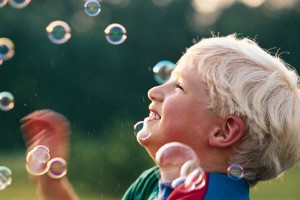International Happy Day is not just for adults, it’s for children too. Contrary to what we assume, kids are not automatically happy, without a care in the world, playing all the day long. The world can be very scary and confusing place and children have limited language to tell us what they need. Their time and space to play is increasingly under threat. As parents and caregivers we can influence the happiness of our children.
 According to Dr. Laura Markham in her book Teaching Your Child the Art of Happiness, happiness is less related to luck and more something we create, a product of our “mental, emotional, and physical habits.” What can we do to help children enjoy happiness?
According to Dr. Laura Markham in her book Teaching Your Child the Art of Happiness, happiness is less related to luck and more something we create, a product of our “mental, emotional, and physical habits.” What can we do to help children enjoy happiness?
Feeling happy is an emotion. We can help children learn about emotions by talking about them, reading stories, noticing when they feel different emotions and naming them, making faces in the mirror and guessing what feeling they show, and sharing information about our own emotions. Either our emotions can control us, or we can deal with our emotions. It is critically important that we help children develop the skills to handle their own emotions. We can even sing about them:
If you’re happy and you know it, clap your hands…
If you’re angry and you know it, stamp your feet…
If you’re sad and you know it, cry boo hoo…
(Tune: If You’re Happy and You Know It.)
Add any other verses you can think of.
Another study showed the kids who know more about their family history had a greater belief that they could control their world and a higher degree of self-confidence. It was the number one predictor of a child’s emotional well-being. (Drs. Marshall Duke and Robyn Fivush) Share stories about the family and include time to connect with each other, such as eating a meal together.
Physical habits such as eating well, getting a good sleep, and plenty of outside and active time are ones that we can start with kids long before they go to school.
When it comes to mental development, do you know how a child learns best? PLAY. Make sure each day has time for active, imaginary, sensory, and discovery play. This doesn’t require expensive toys and programs. An empty box, a stick, and a pile of dirt are tremendous for play. So are balls, blocks, puzzles, and dolls.
There are two other qualities that are perhaps beyond emotional, mental, and physical levels. These are being grateful and kind. Being thankful allows us to find joy all around. Allowing children to help in the family and community gives them the opportunity to develop and experience the glow of kindness.
Life is challenging no matter our age, even for children. If we help children discover and develop happiness now, they will remember as they grow up. Happy day!
How about you? When are you happy?
